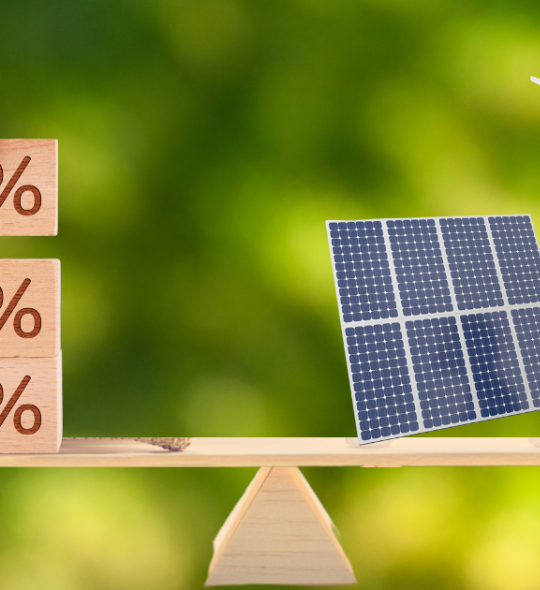
Record inflation is hurting businesses, but there’s a way to avoid it and continue investing in cleantech projects.
TL;DR
-
Electricity price inflation is making energy bills and the solutions to lower them more expensive.
-
The supply of renewable energy projects and trained workers aren’t keeping up with investor demand.
-
Material shortages are creating more hurdles for renewable energy developers, particularly in solar and wind.
Inflation is taking a bite out of the bottom lines of many companies, due to pandemic-related spending and supply-chain bottlenecks.
Surging energy production costs and a decline in fossil fuel production is also driving rapid electricity inflation.
What does your business need to know about energy inflation, and what will keep you a step ahead?
Renewable energy construction impacted by inflation
The global economy is rebounding from the COVID pandemic and demand for fossil fuels is increasing. At the same time, global tensions are impacting fossil fuel supplies and rapidly driving up prices.
These higher prices are leading to rising electricity price inflation forecasts. This is because oil and natural gas supply a large part of baseline capacity. Spikes in natural gas prices in particular lead to greater volatility in electricity prices.
For example, the European Central Bank (ECB) reported the wholesale electricity price in the EU jumped to €196 ($221) per megawatt. This is four times higher than the average from two years ago. These price spikes create more demand for clean, efficient energy solutions, further increasing demand-side inflation.
Normally this would be good news for renewable energy projects, making them more attractive. But for the first time, renewable project costs are also rising.
Higher electricity and fuel prices are costing businesses more money, but the solutions — renewable energy construction and efficiency upgrades — are also becoming more expensive.
This rush for renewable energy development has indirectly impacted the business landscape in a number of ways. Overall, Bank of America found that this demand for renewables could add more than three percentage points to inflation.
For instance, the lack of workers with the right skills is leading to wage inflation, while the pandemic and the ‘Great Resignation’ are putting stress on the labor market.
Meanwhile, renewable energy developers are increasingly demanding higher electricity prices in government-led power auctions to recover costs.
More and more businesses are transitioning to cleantech in their energy portfolios. Being a heavy polluter is bad for the bottom line and hurts your brand image.
“You will not actually get cheap money for anything that’s a climate risk. Whereas for renewables the market is softening,” explains Gauri Singh, Deputy Director-General at the International Renewable Energy Agency (IRENA).
All told, businesses face mounting costs in their energy projects, but many don’t have the upfront funding to move quickly.
Material costs a headache for renewable energy developers
For a long time, prices for cleantech components were falling. Nick Parsons, head of research at Thomas-Lloyd Group, explains that “over the past 10 years, there have been three certainties in life: death, taxes, and lower prices for solar panels.”
However, this trend has been disrupted recently; solar panel prices jumped by more than 50 percent in 2021 compared to 2020. Wind turbine costs also rose by 13%, and the first-ever rise in battery prices occurred.
The per-watt cost of photovoltaic panels sank from 40 cents in 2016 to 20 cents in 2020, before rising past 30 in Q4 2021. For example, Encore Renewable Energy in Vermont recently reported paying 35 cents per watt for panels, according to CEO Chad Farrell.
Similarly, the Solar Energy Industries Association (SEIA) and Wood Mackenzie forecast a 15 percent decrease in solar installation in 2022 due to rising costs.
The price of polysilicon (the building block for solar panels) has quadrupled since the start of 2020, putting many projects in jeopardy. The International Energy Agency (IEA) reports an additional 95 gigawatts (GW) of renewable energy construction (from solar alone) would be on track to come online by 2026, if material costs weren’t rising. That’s enough capacity to power 71 million U.S. homes.
Similar trends are occurring in the wind sector, with Vestas Wind Systems — the world’s largest wind turbine manufacturer — cutting their profit forecast for 2022. GE Renewable Energy has also lost $800 million in its offshore wind business due to inflation.
Helping your business manage electricity inflation
Inflation can create doubt for energy programs, but waiting for upfront funding or the right financing deal will cost you much more. But there is a way for your business to beat it.
EnPowered Payments will help you unlock stalled energy projects and accelerate the adoption of cleantech. Our on-bill payments platform helps solution providers sell more by turning the up-front expense into a line item showing savings on your prospective client’s electricity bill. And that’s a benefit your competitors can’t provide.
With Payments, you can avoid passing inflation costs on to your customers and help them save on their electricity bills. This allows your clients and other energy users to get their projects off the ground and start saving right away.
Contact us today to learn how EnPowered Payments can help you outmaneuver inflation and achieve your energy goals.





